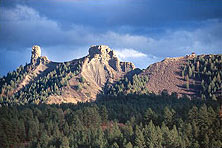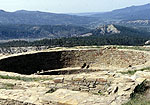Story
Chimney Rock Archaeological Area
Twenty-two miles west of Pagosa Springs in the San Juan National Forest, a pair of distinctive rock pinnacles stand guard over one of the most intriguing archaeological sites in the Four Corners region. The lofty landmarks, known today as Chimney Rock and Companion Rock, guided nineteenth-century American prospectors who were searching for silver and gold in the San Juan Mountains.
Before that, they served as guideposts for Spanish explorers and missionaries. Earlier still-more than a thousand years ago-prehistoric Indians lived in their shadow. To these Ancestral Puebloan peoples, the rocks and the high mesa upon which the formations stand were more than distinctive geological features; they were sacred places. In 1996, the State Historical Fund supported a project to increase public awareness of the site and preserve its ruins from continued deterioration. In all, the State Historical Fund has provided more than $101,000 in grants for archaeological surveys and interpretation at the site.
The Chimney Rock Archaeological Area, listed in the National Register of Historic Places in 1970, includes the High Mesa ruins near the rocky pinnacles and many other sites located at lower elevations. Some scholars estimate that up to 2,000 Ancestral Puebloan people lived here between A.D. 925 and 1125. According to the religious traditions of modern Taos Pueblo Indians, the spires may have been shrines to the Twin War gods. The Southern Ute Indian Tribe, which owns the land surrounding the Chimney Rock area, holds the pinnacles and ruins sacred as well. Extensive portions of the masonry buildings have been stabilized and reconstructed for today's visitors.
Around 1076, a group of newcomers joined the existing Ancestral Puebloan People living near Chimney Rock. They built the Great House, known also as the Chimney Rock Pueblo, which contains two kivas (round ceremonial rooms) and thirty-six other ground-floor rooms. Archaeologists theorize that the new arrivals came from the great Ancestral Puebloan civilization at Chaco Canyon, New Mexico. If this is true, the Great House Pueblo was the most isolated and highest of the Chacoan "outliers," or Southwestern commercial satellites, of Chaco Canyon.
Some archaeologists have suggested that the new arrivals may have been priests who built the Great House for religious and astronomical reasons. Armed with the knowledge that the ancient Chaco Canyon people established ceremonial calendars by watching the movements of celestial objects, University of Colorado scholar J. McKim Malville made a startling discovery. Every 18.6 years, during an astronomical event called the "Northern Lunar Standstill," the moon rises directly between Chimney Rock and Companion Rock-the Twin War Gods-as seen from the mesa near the Great House. Even more interesting, the pueblo's construction may correlate with this lunar event.
Over time, erosion reduced the Great House and other structures to ruins. Beginning in 1970, the U.S. Forest Service and Dr. Frank Eddy of the University of Colorado at Boulder began repair and restoration work on the site's major excavated structures. In addition, visitor facilities have been installed, including vehicle access and parking, a visitor station, wheelchair-accessible trail, interpretive signage, and toilets to accommodate the 15,000 visitors who come to Chimney Rock each season. In 1996 the San Juan Mountains Association, the U.S. Forest Service, and the State Historical Fund joined forces to halt further deterioration of the Great House while increasing public awareness of the site. The project entailed two steps. First, the partners documented the pueblo, stone by stone, with computer-aided architectural drawings. These renderings will allow archaeologists and preservationists to plan future stabilization work. Second, partners brought the Great House ruin to life by creating a 3-D video presentation showing how the site was built and how it may have changed over the centuries. Thanks to this technology, those who cannot make the difficult climb to the mesa's top can investigate the site's most remote features and understand their historical-and perhaps spiritual-significance.
Despite the project's intensive documentation, the Chimney Rock Archaeological Area remains a mystery. And rightfully so. By helping to preserve the ruins, the State Historical Fund has helped sustain the wonder that the Ancestral Puebloan people may have felt when they watched the moon rise between twin rock pillars at precisely the same time every 18.6 years.



